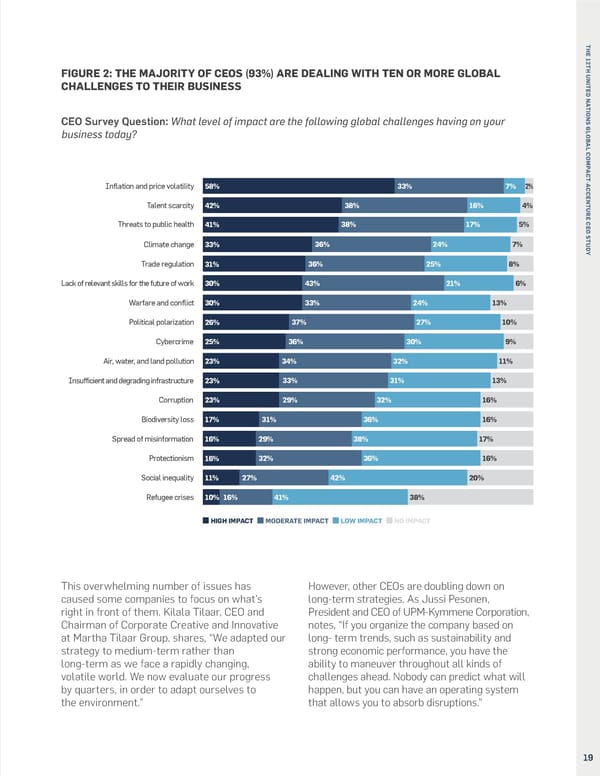T H E 1 2 T FIGURE 2: THE MAJORITY OF CEOS (93%) ARE DEALING WITH TEN OR MORE GLOBAL H U BUSINESS AS USUAL IS NO MORE – TODAY’S OPERATING N I T CHALLENGES TO THEIR BUSINESS E ENVIRONMENT IS DEFINED BY CONSTANT DISRUPTION D N A T I O N CEO Survey Question: What level of impact are the following global challenges having on your S G L business today? O CEOS ARE FACING AN ESCALATING shortages, geopolitical issues, inflation, water B A NUMBER OF CHALLENGES and energy crisis.” CEO of ARPA, Clara Arpa, L C O M SIMULTANEOUSLYadds, “It seems that every day we wake up with a P A C T different problem, and none of the previous ones - A Inflation and price volatility 58% 33% 7% 2% C CEOs are operating in an unchartered new world, have been solved.” C E N which is treacherous to navigate. The sheer Talent scarcity 38% 16% 4% T 42% U R number of challenges facing the private sector is CEOs are overwhelmed by the sheer number of E C Threats to public health 41% 38% 17% 5% E breaking new boundaries. From a non-exhaustive challenges they are required to address, coupled O S T list of global challenges facing businesses, 93% Climate change 33% 36% 24% 7% U with the uncertainty of the future. Case in point, D of CEOs said they are dealing with the impacts 91% of CEOs say that too many competing Y Trade regulation 31% 36% 25% 8% of 10 or more (Figure 2). Even more alarming, priorities hinder progress in building resilience. 46% of CEOs stated that they were dealing with According to Ramesh S. Ramakrishnan, Lack of relevant skills for the future of work30%43% 21% 6% all 17 challenges surveyed in some capacity. Chairman of Transworld Group, “The world Warfare and conflict30%33% 24% 13% As Christophe Beck, Chairman and CEO of Ecolab, today is filled with so many challenges, I don’t notes, “Disruption has been huge over the last think there is anyone that can predict the future. Political polarization26%37% 27% 10% few years, and what’s really unique right now I don’t even know if historical data is as helpful Cybercrime25%36% 30% 9% is that none of those disruptive forces have anymore, when the world has evolved so much. gone away – starting with COVID, to the supply We need new solutions for new problems.” Air, water, and land pollution23%34% 32% 11% Insufficient and degrading infrastructure 23% 33% 31% 13% Corruption 23% 29% 32% 16% Biodiversity loss 17% 31% 36% 16% Spread of misinformation 16% 29% 38% 17% Protectionism 16% 32% 36% 16% Social inequality 11% 27% 42% 20% Refugee crises 10% 16% 41% 38% HIGH IMPACT MODERATE IMPACT LOW IMPACT NO IMPACT This overwhelming number of issues has However, other CEOs are doubling down on caused some companies to focus on what’s long-term strategies. As Jussi Pesonen, right in front of them. Kilala Tilaar, CEO and President and CEO of UPM-Kymmene Corporation, Chairman of Corporate Creative and Innovative notes, “If you organize the company based on at Martha Tilaar Group, shares, “We adapted our long- term trends, such as sustainability and strategy to medium-term rather than strong economic performance, you have the long-term as we face a rapidly changing, ability to maneuver throughout all kinds of volatile world. We now evaluate our progress challenges ahead. Nobody can predict what will by quarters, in order to adapt ourselves to happen, but you can have an operating system the environment.” that allows you to absorb disruptions.” 18 19
 Accenture CEO Study United Nations Global Compact Page 18 Page 20
Accenture CEO Study United Nations Global Compact Page 18 Page 20